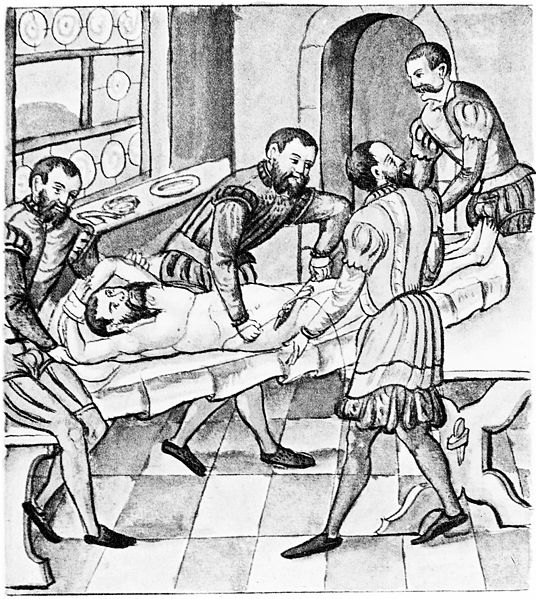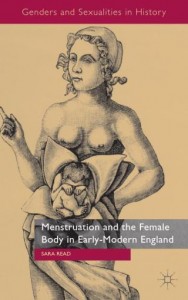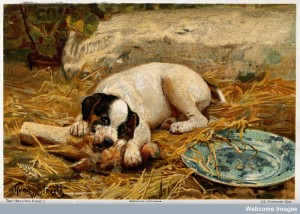
This week’s blog post takes the form of a video produced by Dr Christelle Rabier and Dr Jon Adams called ‘Capturing the Cut’.
In it we return again to the topic of bladder stones and lithotomy.
In the eighteenth century, surgeons were rapidly developing new techniques for invasive surgery. But how to transmit this information? Only a very few students at a time would be able to watch a procedure, and even then, it wasn’t clear what was happening amid the throng of assistants required to restrain the un-anaesthetised patient.
Early medical illustrations offer little information to the prospective surgeon, but over the course of a hundred years, a series of conventions emerged – cross-sections for interior views, dotted lines for motion, and the transposition of multiple sequential events onto the same plate – all of which meant that by the beginning of the nineteenth century, illustrators were able to depict the actual process of surgery, and spread medical innovations further afield than the confines of a single theatre.
Christelle Rabier, Wellcome Trust Medical History Fellow, focuses on the material, economic and political dimensions of medicine in early modern Europe. Her publications include Fields of Expertise (CSP, 2007) and a forthcoming special issue in Technology and Culture on the economy of medical technology in early modern Europe (July 2013). Her monograph, from which the argument of the video is drawn, will be published as Chirurgiens des Lumières–Surgeons of the Enlightenment (Vendémiaire, 2013).
Jon Adams grew up in Derbyshire and Saudi Arabia, studying literature and philosophy at the universities of Keele and Durham. From 2005 he was a researcher with LSE’s “How Well Do ‘Facts’Travel?” project, investigating how fiction is sometimes used to popularise scientific ideas. His first book, Interference Patterns, on the methodology of literary criticism, was published in 2007. He began producing short films for LSE in 2009, co-authored two papers on crowding and urban decay, and in 2011 was selected as a New Generation Thinker by BBC Radio 3.
© Copyright Christelle Rabier and Jon Adams, all rights reserved




This video sent me at once to Encyclopaedia Britannica‘s First Edition (3 vol., 1768-71), which treats in great detail and several pages of engravings the subject of surgery and midwifery. No cutting motion though I think you’d find it of interest.
One ought to consider why practitioners would want to publish anything at all, and particularly why they would want to communicate knowledge of special treatments for disease or operations that required a high level of skill and practice.
In large part, clergymen published sermons to please patrons and to publicize their own claim to preferment. Bishops did not publish much, unless they were stuck in some poor diocese. So too physicians wrote monographs and case histories to advertise their abilities among both potential patients and learned physicians who might wish to consult with them. Royal physicians and leading members of the College did not publish much. In either profession, innovatory work could discourage patrons, as in the case of William Harvey.
How much information would, say, Cheselden want to publish about his lithotomy and opthalmic operations? He needed to be more widely known as a great expert, especially when he toured the provinces, but he surely had no interest in being so informative that he could be imitated. Discussion of theory, to impress colleagues, and examples of success would be far more useful to him.
I will make sure that your comments are passed on to the author of this blog post. Personally I think that these very issues are part of what makes printed medical texts so fascinating and, in places, so frustrating to use. The way in which they frame their narratives and the information they choose to publicise or hide is incredibly interesting.
Indeed, why did surgeons – or other medical practitioners – publish books in the first place? The issue, contrasted with clergymen, is less straightforward that it seems. Being acknowledged might be one: it is the case when surgeons promoted their own instruments or techniques, such as Claude Pouteau of Lyons who had developed a lithotom and resorted to publishing for convey instructions of use – as well as marketing his technique. Early-career publishing was indeed less common than printing at a later age it is more likely to promote one’s ideas. Cheselden’s editorial strategies was unique in using the whole scope of editorial funding for his project. In the first instance, he published a small illustrated textbook which also served as an advertisement his private anatomy courses -whose editorial success served later more risky editorial adventures. Made assistant and that surgeon at St. Thomas, he used his Treatise on the Stone (1724) to promote his surgical techniques, using its outcomes as a test for success. For his expensive anatomical atlas, from which only the Osteologia appeared in print, he requested subscription before (most likely) giving away part of the benefits drawn for his textbook Anatomy of the Humane Body to his publisher Bowyer to economic recovery. For his experience of iridectomy, both rare and unique, he used the free channel of the Philosophical Transactions. In a sense, he was willing to disclose some information as a way of promotion (fee-paying course; special technical skills). But, as the recourse to subscription, articles in learned journals and repeated and improved editions of more humbler work attest, as well as his correspondence with the Académie royale de chirurgie, William Cheselden was also interested in promoting his own view on individual techniques, understanding of diseases and cures, as well as making knowledge accessible to a wider audience of (learning) surgeons. By doing so, illustrations proved a useful tool.